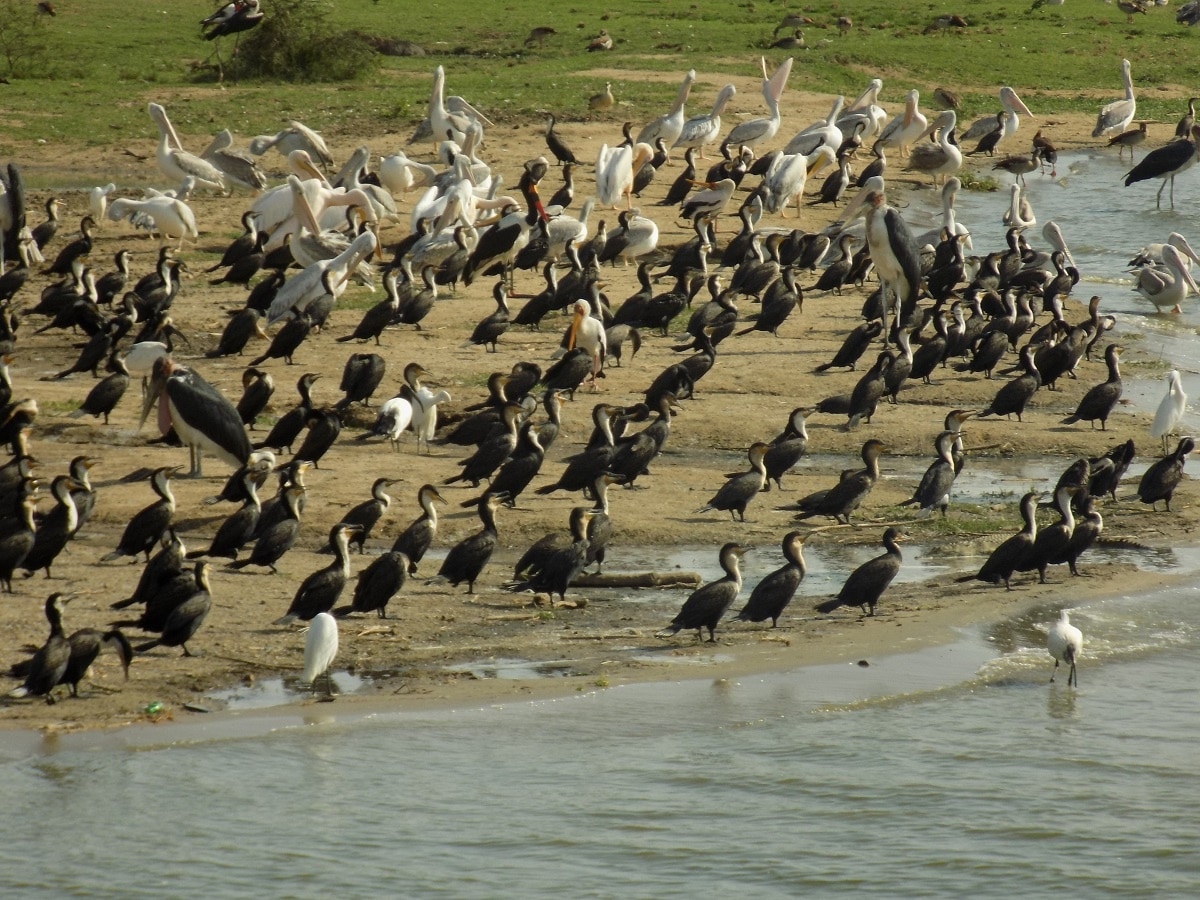BIRDING IN UGANDA
7-DAY BIRDING TOUR IN QUEEN ELIZABETH NATIONAL PARK.
Day 1: Arrive at Entebbe Airport and you are met by our Guide and driven to a Hotel in Kampala.
Day 2: Drive down to Kasese town with a stopover in Fort Portal for lunch and thereafter drive to Kasese for an overnight at your hotel or community campsite near Queen Elizabeth National Park.
Day3: After breakfast drive towards the forest and take a long walk in the Maramagambo Forest , where you can find a variety of birds, forest antelope, monkeys, a bat cave and the ‘cormorant house’ a large tree in the forest that has been turned white by the birds that roost there at night and drive back towards Kyambura for a night.
DAY 4: Wake up and have your breakfast, spend the morning tracking chimps in Kyambura Gorge . Explore this ‘underground forest’ before a picnic lunch overlooking the gorge, or at one of the nearby lodges. In the afternoon take the Crater Lake Drive to the Baboon Cliffs for sundowners and relax for a drink at Katunguru.
DAY 5: After breakfast, bird your way to Ishasha sector with your packed lunch. Look out for species like the Black-headed Heron, African White-backed Vulture, African Harrier-hawk, African Crowned eagle, Helmeted Guinea fowl, Black bee eater, Blue–breasted Kingfisher, White-headed Barbet, Double-toothed Barbet, Tinkerbirds, Nubian Woodpecker, Apalises, Greater Honeyguide, White-browed Robin-chat, Sooty Chat, African Moustached Warbler, Zitting Cisticola, CroackingCisticola, Babblers, Copper Sunbird, Grey-backed Shrike, Common Fiscal, Sulphur-breasted Bush-shrike, Black-headed Gonolek, Black-crowned Tchagra, Brown-crowned Tchagra, Fork-tailed Drongo, Starlings, Widowbirds, Finches, Waxbills and many more. Spend the night at a lodge or campsite in Ishasha.
DAY 6: After breakfast, head south to view birds at the Edward Flats coming back to your lodge in time for lunch. Proceed to Ntungwe and nearby tracks, coming back in time for a shower and dinner. Look out for birds like the Cattle egret, Hamerkop, Storks, Shoebill, Ibises, Raptors, Red-necked Spurfowl, Black-bellied Bustard, Temminck’s Courser, Senegal Lapwing, African Wattled Lapwing, Brown Parrot, Diederick Cuckoo, White-browed Coucal, Blue-naped Mousebird, Striped Kingfisher, Little Bee-eater, Broad-billed Roller, Common Scimitarbill, White-headed Barbet, Larks, Yellow-throated Longclaw, Pipits, Sooty Chat, Cisticolas, Northern Black Flycatcher, Babblers, Sunbirds, Shrikes, Black-headed Gonolek, Black-crowned Tchagra, Brown-crowned Tchagra, Fork-tailed Drongo, Starlings, Weavers, Widowbirds, Finches and Waxbills among others. Look out for mammals like Uganda kobs, bushbucks, defassa waterbucks, buffaloes, elephants, warthogs… and if lucky a tree climbing lion or a leopard!
DAY 7: After breakfast, pack your luggage and proceed back to Kampala or Entebbe, birding en-route and arriving in the late afternoon. Look out for birds like the Nubian Woodpecker, Bateleur, Crested Francolin, Blue-spotted Wood Dove, Brown Parrot, Bare-faced Go-away-bird, Lilac-breasted Roller, Broad-billed Roller, Striped Kingfisher, Blue-napped Mousebird, African Grey Hornbill, Spot-flanked Barbet, Fork-tailed Drongo, Cisiticolas, Weavers, Widowbirds, Finches and Waxbills among others. Cost per person: $2240 ( includes, all park fees, chimp permit, guiding fee, 7day transport in 4x4 open roof car and government taxes and it excludes accommodation and meals in hotels, insurance )


.
Note: we can book for you accommodation of your choice it ranges from $20 - $320 and meals range from $5-$10. Wildlife and birding summary Birds Birding in Queen Elizabeth National Park is an incredible treat as it contains a variety of habitats that range from savanna to wetlands to lowland forests.
This diversity is reflected in the list of over 600 bird species, the biggest of any protected area in East Africa. A majority of the birds found in this area are regarded as famous birds of East Africa and are a must see for birdwatchers in Africa! Big Game With an astonishing 5000 hippos, 2500 elephants and over 10,000 buffalo thriving in its grasslands and shorelines, Queen guarantees sightings of some of Africa’s most iconic species. Hearing the elephants’ calls reverberate around Queen’s crater-filled valleys is a magical experience. Other common herbivores include warthogs, waterbuck, Uganda kob and topi, as well as the sitatunga antelope.
Primates Ten species of primates enjoy the park's diverse habitats, the most popular of which is undoubtedly the chimpanzee. Vervet and black-and-white colobus monkeys are easily spotted in the trees, but the boldest of all are the baboons – be sure to keep car windows closed to avoid food thefts! Big Cats Queen’s most elusive inhabitants are its felines: lion, leopard, civet, genal and serval cats. Lions are found throughout the park, but the most renowned live in the southern sector of Ishasha, where they rest on the limbs of fig trees. Solitary leopards are nocturnal and fiendishly well camouflaged, making a glimpse all the more rewarding! The smaller cats are also predominantly nocturnal and best spotted on night game drives.